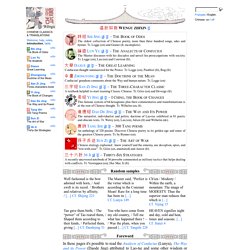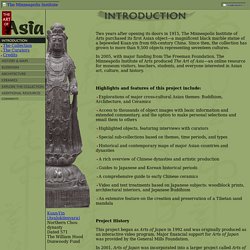

Inside China’s Cult of the Cat. It’s 2021, and China is on the verge of being conquered by a race of seemingly innocuous, but actually hyper-intelligent, imperious overlords.

That’s not the plot of some B-movie thriller. It’s barely an exaggeration. According to the 2020 Chinese Pet Industry White Paper, China’s pet cat population rose by a staggering 10.2% last year to almost 49 million. If current trends continue, cats will overtake dogs to become the country’s most popular pet in the next year or two. If anything, those numbers undersell cats’ cultural hegemony. Especially curious is how obsequious these cat lovers are toward their feline overlords. Needless to say, any suggestion that China’s cult of the cat has gone overboard brings the claws out. How did cats win all this love and adoration? The first of these layers directly relates to how cats look.
Accent Expert Gives a Tour of U.S. Accents - (Part One) 滇西小哥的微博_微博. How Li Ziqi Repackages Rural China For Urban Fantasies. Pastoral-Life Vlogger Sparks ‘Cultural Export’ Debate. A prolific vlogger from a village in southwestern China has become a hot topic online, where Chinese netizens are debating her suitability as a cultural ambassador for the country.

Li Ziqi, a 29-year-old Sichuan native with over 55 million followers on social media, began making videos on Chinese video-sharing platform Meipai in 2016 after giving up her life as a migrant worker in the city to return to her village and live with her grandmother. Li’s videos are an escape from the relative chaos of urban life: Against a soundtrack of comforting traditional Chinese music, Li gracefully performs the daily work of a farmer, from harvesting vegetables and tending chickens to building an earthen oven and making her own soy sauce. Among Chinese netizens, Li isn’t the most popular web celebrity. Instead, it’s her international appeal that has landed her in the spotlight. Li boasts 27 million subscribers on short-video app Douyin and 21 million followers on microblogging platform Weibo.
Chinese Names. In China, as in other Asian countries, the surname is written first, then the given names.

For example: Wu Gongfu — The last name is Wu (like Smith, Jones, etc.) and the given names are Gong and fu (written together in Pinyin and hyphenated in Wade-Giles, Wu Gong-fu). In China, what is most important about a person is that he/she has a family, or is part of a family, hence the last name comes first. Of second importance is the individual name. Very often when speaking to a Chinese person the whole name is said: "Hi, Wu Gongfu! " Chinese names give a good picture of how the Chinese view the world and the importance of the family. In the first two lists of names, read the English translation from top to bottom. 古诗文网-古诗文经典传承. Wengu - Chinese Classics. Revue de presse / Press review Harrison Z.

Huang, Ph.D student at socrates.berkeley.edu, writes : "Analects on the AFPC website: This excellent site based in France arrays the Chinese text of the Analects alongside English translations by James Legge (1871) and D.C. Lau. (1979), as well as a French translation by Couvreur. " Jean-Victor Gruat, dans le Portique, écrit : « Hors des sentiers battus et du traditionnel des manuels, gbog nous procure depuis quelques mois d'ineffables plaisirs sur son site [...] Ce qui fait toute l'originalité et le charme du travail particulièrement méticuleux de gbog, c'est la présentation des textes sous une forme respectant la tradition de l'époque, caractères inscrits sur des faisceaux de planchettes de bambou que l'on déroulait pour les lire, avec l'utilisation de techniques modernes et légères d'annotation informatique [...] » En Suisse, sinoptic.ch écrit : « [...] site riche et esthétiquement très réussi [...].
Building China: Why Does Half of China Struggle to Stay Warm Indoors in the Winter? Why China’s Students Are Being Told to Kneel Down and Take a Bow. In recent years, there has been an uptick in reports of Chinese students being required by their schools to kowtow — do deep bows in which their heads touch the ground — before their parents.

Two months ago, nearly 2,800 high schoolers in the central province of Henan were made to kowtow to their parents in a mass ceremony. Last January, a viral video from the eastern province of Shandong showed a tearful woman — a member of a local nonprofit — ordering about 100 students to kowtow to their parents. When reporters contacted the school’s principal for comment, he defended the event and called kowtowing to one’s parents a “good Chinese tradition.”
"I'm So Qiou" - The New Chinese 'Character of the Year' is 'Dirt-Poor & Ugly' Chinese Cultural Studies. The Art of Asia - Introduction. Two years after opening its doors in 1915, The Minneapolis Institute of Arts purchased its first Asian object—a magnificent black marble statue of a bejeweled Kuan-yin from 6th-century China.

Since then, the collection has grown to more than 9,500 objects representing seventeen cultures. In 2005, with major funding from The Freeman Foundation, The Minneapolis Institute of Arts produced The Art of Asia—an online resource for museum visitors, teachers, students, and everyone interested in Asian art, culture, and history. Highlights and features of this project include: Explorations of major cross-cultural Asian themes: Buddhism, Architecture, and Ceramics Access to thousands of object images with basic information and extended commentary, and the option to make personal selections and email them to others.
Performing Arts. Cinema. Fine Arts. Food. Tea 茶. Architecture. Festivals. Pastimes. Beauty Standards. Martial Arts 武术. Museums & Collections.